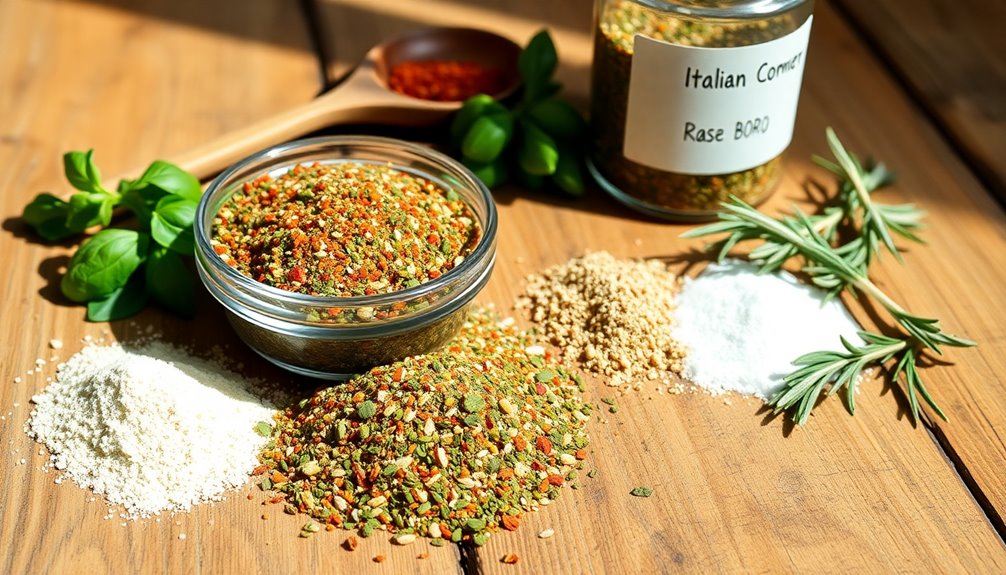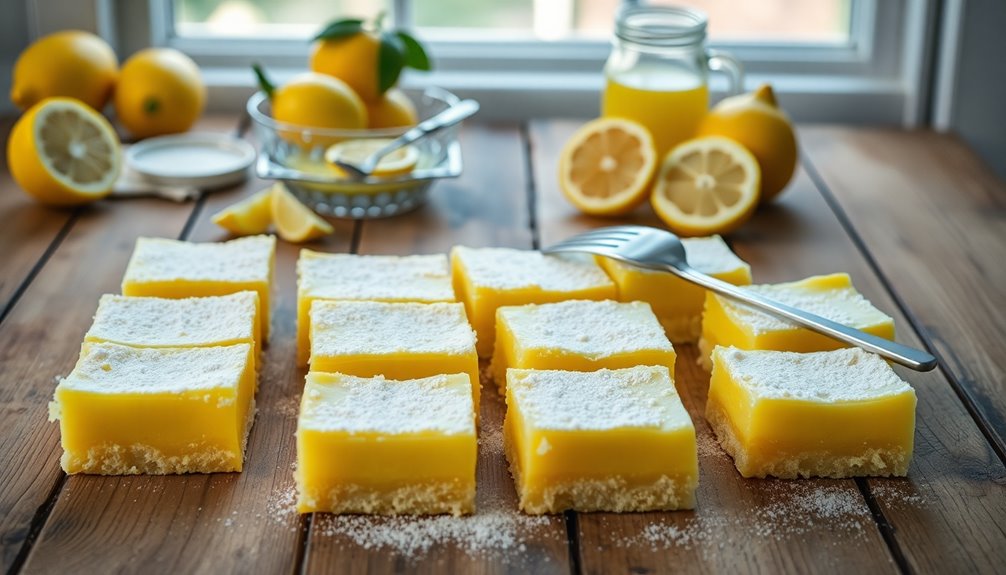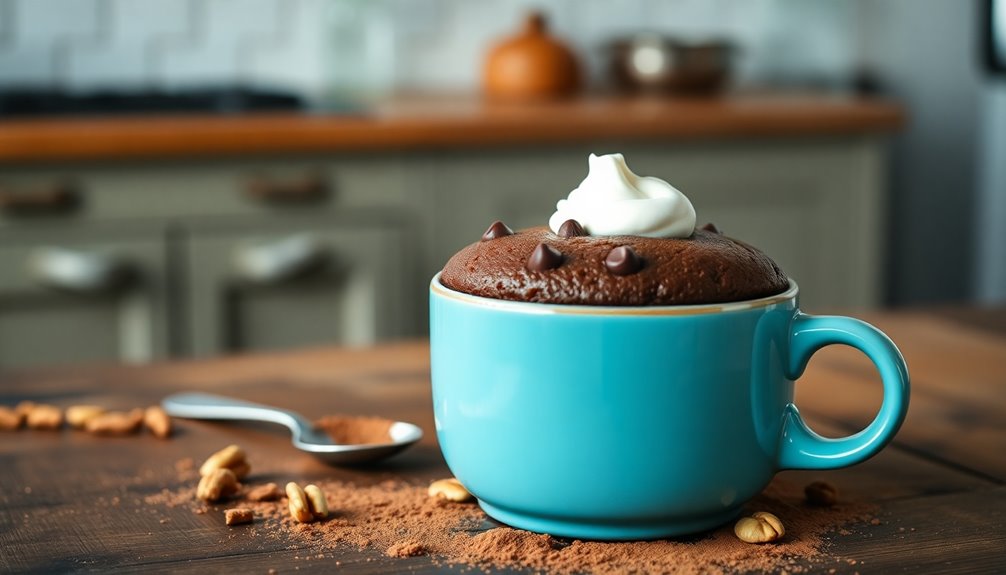You can easily whip up your own Italian seasoning at home to elevate your dishes. Start with equal parts dried basil, oregano, thyme, and rosemary. Add in some parsley, garlic powder, and onion powder for depth. If you like a bit of heat, toss in crushed red pepper flakes. Mix all the dried herbs in a bowl and transfer them to an airtight container. This blend works wonders on pasta, grilled meats, and marinara sauce. Feel free to tweak the quantities to match your taste. Keep going and you'll discover even more ways to customize your seasoning for delicious meals!
Key Takeaways
- Combine dried basil, oregano, thyme, rosemary, parsley, garlic powder, and onion powder for a classic Italian seasoning blend.
- Optional: Add crushed red pepper flakes for a spicy kick.
- Measure herbs accurately and mix in a bowl for even distribution.
- Store the mixture in an airtight container, labeled with the date and name.
- Adjust herb quantities to suit personal taste preferences, experimenting for the perfect flavor.
History
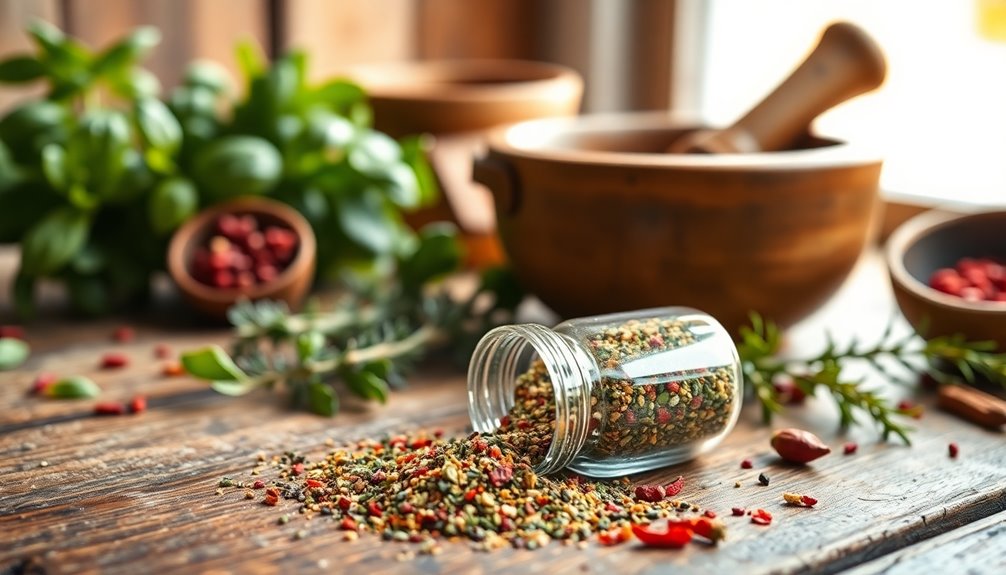
Italian seasoning has a rich history that reflects the diverse culinary traditions of Italy. You might be surprised to learn that this blend didn't originate in Italy itself but was popularized in American kitchens.
Italian immigrants brought their love for fresh herbs to the U.S., where they adapted traditional recipes. Over time, they combined staple herbs like oregano, basil, thyme, and rosemary into a convenient blend.
This seasoning became essential for those wanting to recreate authentic Italian flavors at home. By using it, you tap into centuries of Italian cooking, where each herb brings its unique story and flavor profile.
Recipe
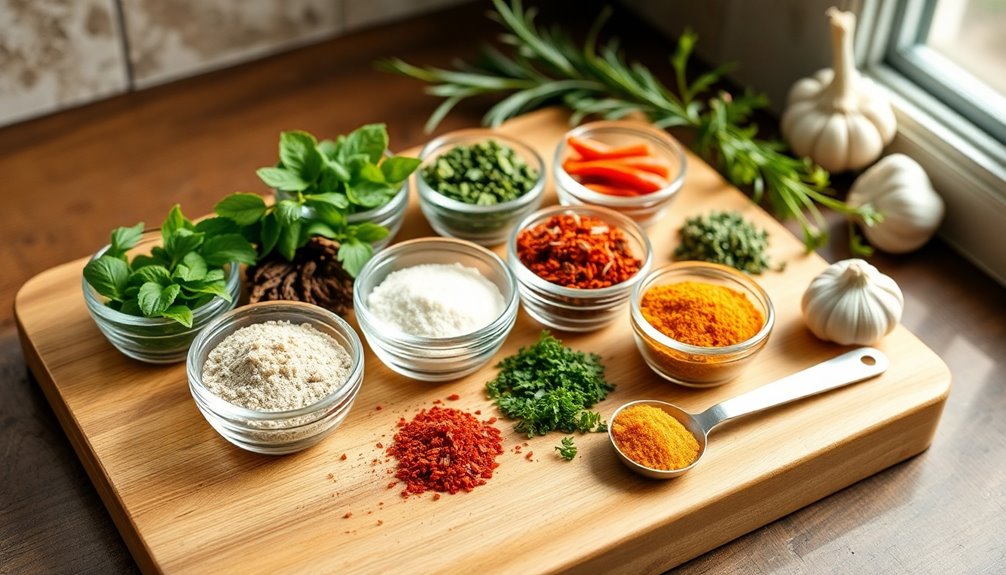
Italian seasoning is a versatile blend of herbs that captures the essence of Italian cuisine. This aromatic mix can elevate a variety of dishes, from pasta to roasted vegetables, with its robust flavors.
Whether you're preparing a homemade marinara sauce or sprinkling it over grilled meats, Italian seasoning adds depth and a delightful fragrance that transports your taste buds to Italy.
Creating your own Italian seasoning at home isn't only simple but also allows you to customize the flavors according to your preferences. By using fresh, high-quality herbs, you can make a blend that's far superior to store-bought versions.
The following recipe will guide you through the process of making your own Italian seasoning mix that you can store and use whenever you need a burst of flavor in your cooking.
Ingredients:
- 2 tablespoons dried basil
- 2 tablespoons dried oregano
- 1 tablespoon dried thyme
- 1 tablespoon dried rosemary
- 1 tablespoon dried parsley
- 1 teaspoon garlic powder
- 1 teaspoon onion powder
- 1 teaspoon crushed red pepper flakes (optional)
To prepare your Italian seasoning, simply combine all the dried herbs and spices in a small mixing bowl. Stir well to guarantee that all the ingredients are evenly distributed.
Once mixed, transfer the seasoning to an airtight container or a spice jar. Label the jar with the date and name of the seasoning for easy identification. Your homemade Italian seasoning is now ready to use!
Extra Tips: When making Italian seasoning, feel free to adjust the quantities of each herb to suit your personal taste. For instance, if you prefer a more robust flavor, you can increase the amount of garlic powder or crushed red pepper flakes.
Additionally, storing your seasoning in a cool, dark place will help maintain its potency. If you'd like a fresher taste, consider using fresh herbs instead of dried, but keep in mind that you'll need to adjust the quantities since fresh herbs are more potent.
Cooking Steps
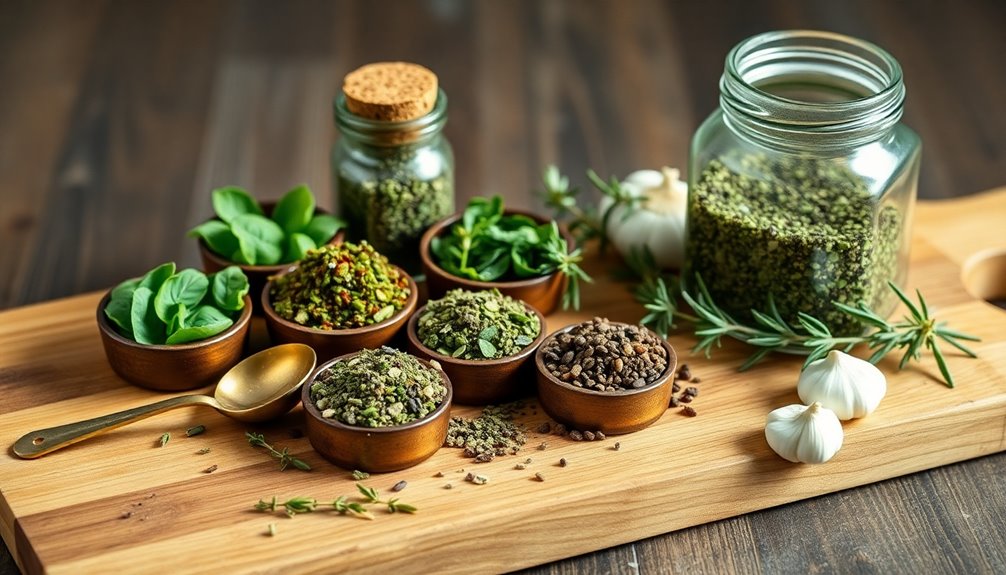
To create your Italian seasoning, start by measuring the dried herbs accurately.
Next, combine them in a bowl and adjust the mix to your taste, adding salt for extra flavor if you like.
Finally, store your blend in an airtight container to keep it fresh.
Step 1. Measure Dried Herbs Accurately
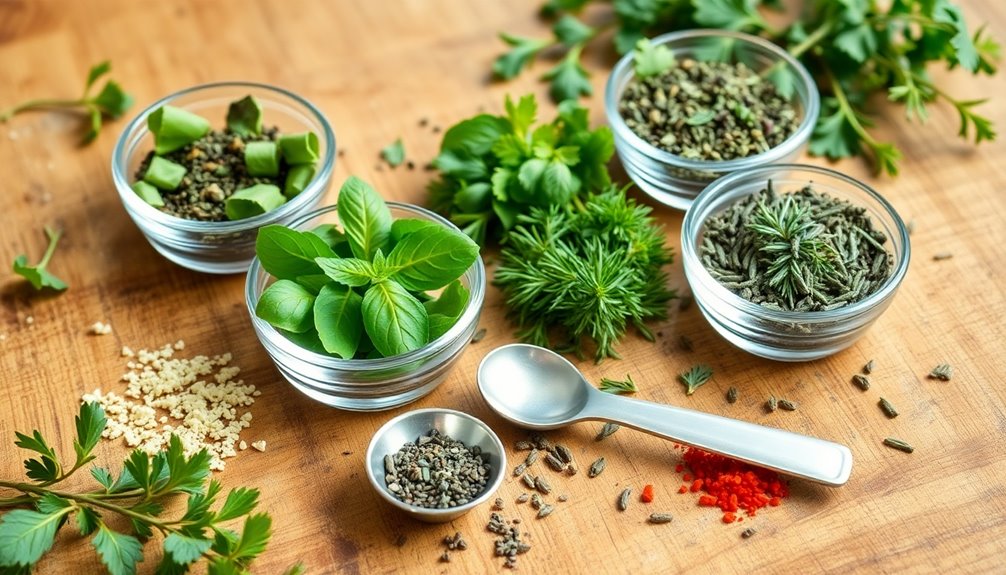
Measuring dried herbs accurately is essential for achieving the perfect balance of flavors in your Italian seasoning. Start by using measuring spoons specifically designed for dry ingredients.
For each herb, scoop a generous amount into the spoon, then level it off with a straight edge, like a knife. This method guarantees you don't pack the herbs too tightly, which can lead to over-measurement.
If a recipe calls for a mix of herbs, remember to measure each one separately before combining them. It's also a good idea to check the freshness of your herbs; older herbs may require slightly more to achieve the same flavor impact.
Consistency in measuring will help you create a delicious and balanced seasoning blend every time.
Step 2. Combine Herbs in Bowl

Combining your measured herbs in a bowl is a simple yet essential step in creating your Italian seasoning blend.
Start by gathering your dried herbs—like basil, oregano, thyme, and rosemary—and place them into a medium-sized mixing bowl.
Using a spoon or a whisk, gently stir the herbs together to guarantee they're evenly mixed. This blending not only enhances the flavor but also makes it easier to use the seasoning in your recipes.
If you find any clumps, break them apart with your fingers to achieve a consistent texture.
Once everything's well combined, take a moment to admire your fragrant blend before moving on to the next step of storing it properly.
Enjoy the delightful aroma of your homemade Italian seasoning!
Step 3. Store in an Airtight Container

After you've mixed your herbs to perfection, it's important to store your Italian seasoning properly to maintain its freshness.
Start by choosing an airtight container; glass jars or plastic containers with tight-fitting lids work well. Make sure the container is clean and completely dry before adding your seasoning. This prevents moisture from spoiling your blend.
Fill the container with your herbs, leaving minimal air space inside to further preserve their flavor and aroma. Label the container with the date, so you can keep track of its freshness.
Store your seasoning in a cool, dark place, away from heat sources and direct sunlight. By following these steps, you'll keep your Italian seasoning vibrant and flavorful for future cooking adventures.
Step 4. Adjust to Taste
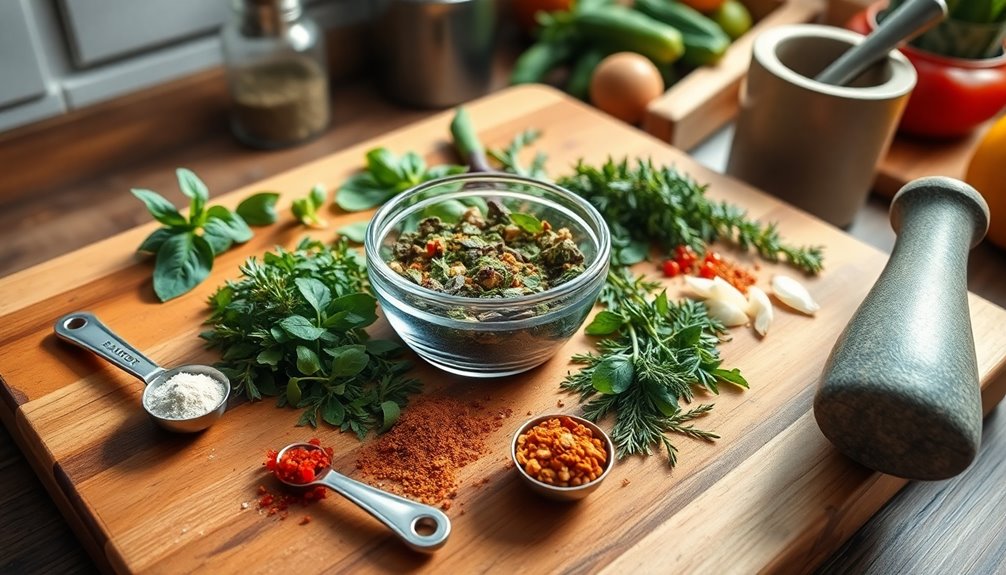
While cooking with your homemade Italian seasoning, it's essential to adjust the flavors to suit your palate.
Start by adding a small amount of the blend to your dish and tasting it. You'll want to reflect on how the herbs and spices interact with the other ingredients.
If you feel it needs more kick, try adding a bit more oregano or basil. For a milder flavor, reduce the amount you use.
Remember, each ingredient has its own intensity, so balance is key. Don't hesitate to experiment; cooking is about finding what works for you.
Keep a notepad handy to jot down adjustments for future reference. Enjoy the process, and soon you'll have a perfectly customized seasoning blend!
Step 5. Add Salt for Flavor
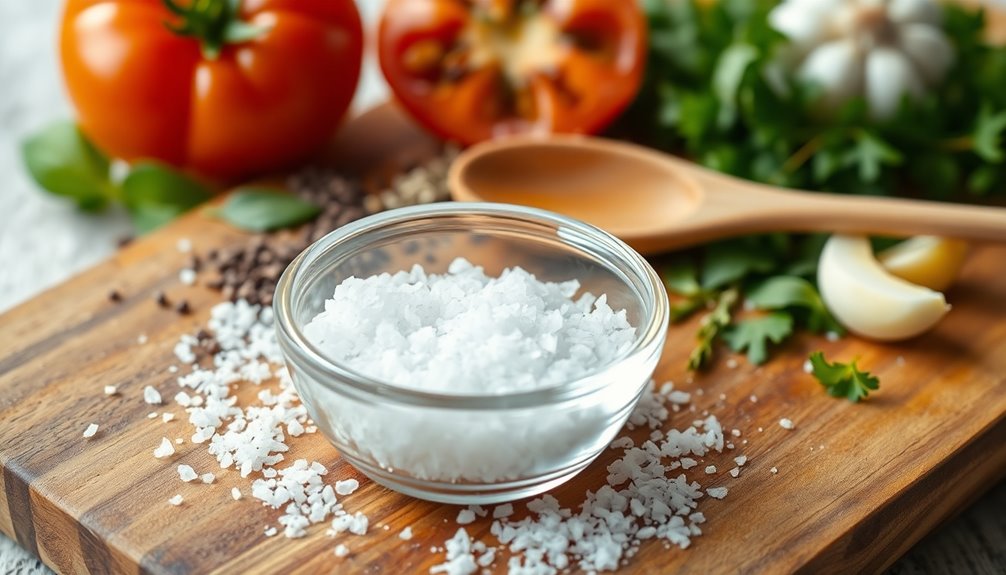
Adding salt is an essential step in enhancing the flavors of your dish. When you're mixing your Italian seasoning, sprinkle in salt gradually. Start with a pinch, then taste to see how it affects the overall flavor.
Remember, it's easier to add more salt than to take it away, so go slow.
If you're using salt in a recipe that also includes salty ingredients like cheese or olives, be mindful of this. You want to complement the existing flavors, not overpower them.
Aim for a balanced taste that highlights the herbs and spices in your mix. Once you find that perfect level of saltiness, your Italian seasoning will elevate your dishes to new heights. Enjoy the delicious difference!
Final Thoughts
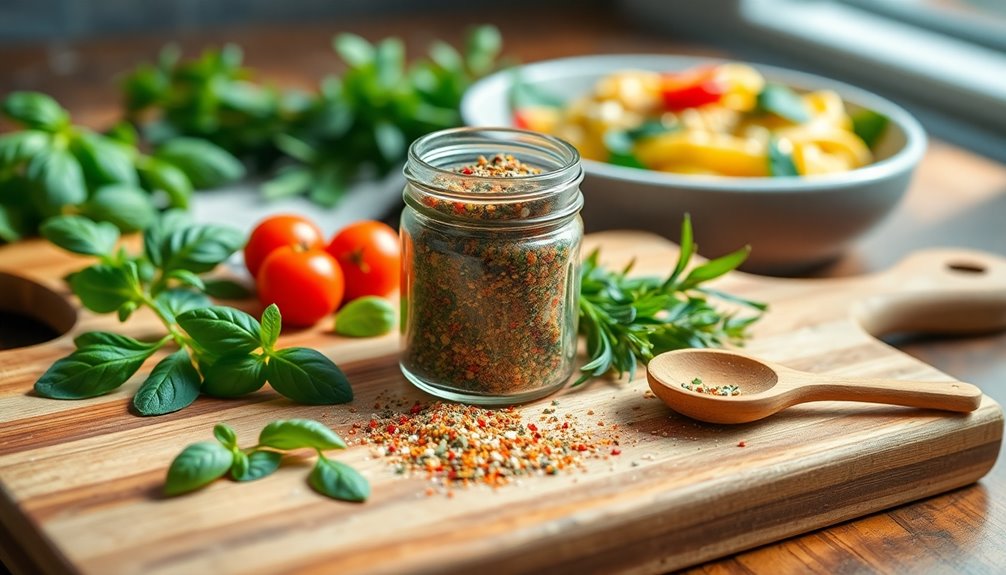
As you experiment with your homemade Italian seasoning, you'll quickly realize how versatile and flavorful it can be. You can sprinkle it on pasta, mix it into marinades, or use it to season roasted vegetables.
The beauty of making your own blend lies in customizing the flavors to suit your taste. Don't hesitate to adjust the proportions of herbs based on what you enjoy most.
Remember, fresh herbs can enhance the taste even further, so consider using them when available. Store your seasoning in an airtight container to keep it fresh.
With just a few simple ingredients, you can elevate your dishes and impress your family and friends. Enjoy the journey of flavor exploration and make Italian seasoning a staple in your kitchen!
Frequently Asked Questions
Can I Use Dried Herbs Instead of Fresh in Italian Seasoning?
Absolutely, you can use dried herbs instead of fresh ones! Dried herbs pack a concentrated flavor, so you might need less than what you'd use if they were fresh.
Generally, a good rule of thumb is to use one-third the amount of dried herbs as you'd fresh.
Just remember to let the dried herbs sit in your dish for a bit longer to release their full flavor.
Enjoy experimenting with your culinary creations!
What Dishes Pair Well With Homemade Italian Seasoning?
Homemade Italian seasoning adds a burst of flavor to many dishes. You can sprinkle it on pasta sauces, roasted vegetables, and grilled meats for a savory kick.
Try it in soups or stews to deepen the flavor profile, or mix it into bread dough for a fragrant twist. It's also great on pizza or in marinades.
Don't hesitate to experiment—your culinary creations will shine with this versatile blend!
How Should I Store Italian Seasoning for Freshness?
To keep your seasoning fresh, store it in a cool, dark place like a pantry or cupboard.
Use an airtight container, preferably glass or metal, to prevent moisture and light from affecting the flavor.
Avoid keeping it near heat sources like stoves or ovens.
If you notice a loss of aroma or flavor, it might be time to replace it, as dried herbs and spices lose potency over time.
Is It Possible to Make Italian Seasoning Without Salt?
Absolutely, you can make seasoning without salt! Focus on using dried herbs like oregano, basil, thyme, and rosemary to create a flavorful blend.
You might also add garlic powder, onion powder, or black pepper for extra depth. Experiment with proportions until you find a mix that suits your taste.
Just remember, while salt enhances flavor, your blend can still be delicious and healthy without it. Enjoy your salt-free seasoning adventure!
How Long Does Homemade Italian Seasoning Last?
Homemade seasoning blends can last quite a while if stored properly. Typically, you'll find that your mix stays fresh for about six months to a year.
To maximize its shelf life, keep it in an airtight container away from light and heat. While it won't spoil in the traditional sense, its potency will diminish over time, so it's best to check the aroma and flavor before using it in your dishes.
